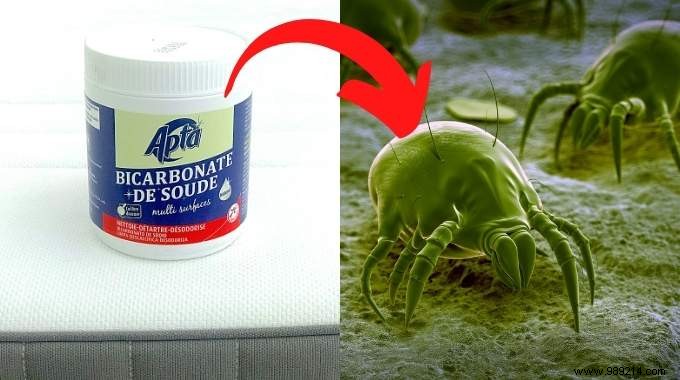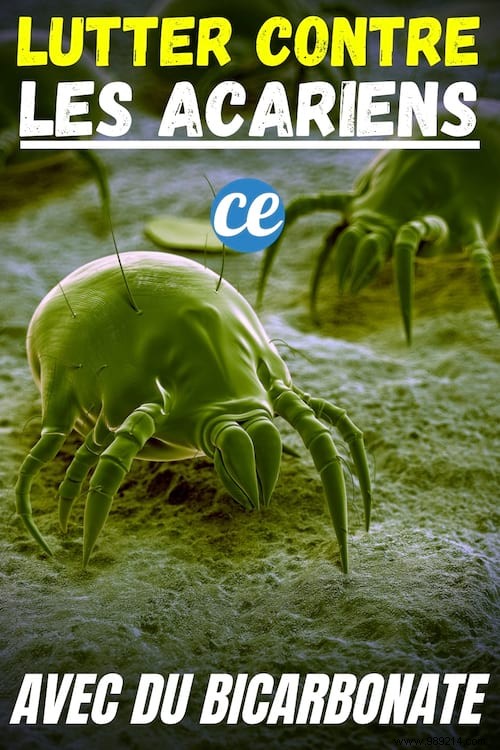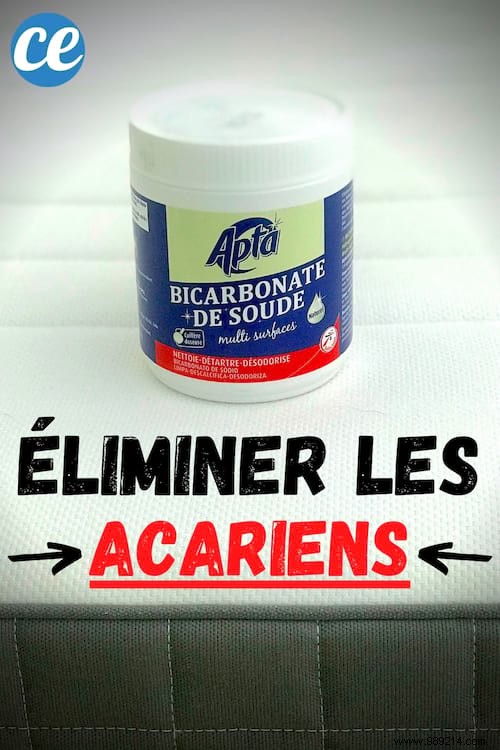
Do close-up pictures of mites make you shiver?
And even more when you think that there are millions in your bed?
It's true that seeing these repulsive little creatures motivates you to clean up your home!
But how to get rid of it without using chemicals, and which method to use for maximum efficiency?
If you ask yourself these kinds of questions, be sure to read the following.
Here's how to scare away dust mites with a 100% natural treatment based on baking soda. Watch:

Sprinkle evenly baking soda over the entire surface to be treated.
Prefer bicarbonate bottles with a powder cap to ensure even distribution
The amount should be 20 grams per square meter, which equals a little more than 1 tablespoon or 4 teaspoons.
If we convert this according to the size of a bed, it's about 35 g for a single bed and about 55 g for a double bed.
Make sure the powder soaks the fibers well and is evenly distributed by gently brushing the entire surface.
Leave to act for at least 2 hours (knowing that 6 to 8 hours are recommended), then give it a little vacuum.
You just have to redo your bed
As for the type of baking soda to use, get a fine-grained product that is more efficient than a coarse-grained baking soda.
Also choose a food-grade baking soda, especially when treating bedding. Check out the trick here.
If the country of dust mites were to exist, it would of course be in a vacuum cleaner bag!
Hair, dust, dander, fur... vacuum cleaner bags are real incubators.
So to limit the development of these dirty little beasts in their microcosm, simply vacuum baking soda from your rugs, carpets or mattresses.
Bicarbonate drastically limits development dust mites in this environment.
Be careful though, it does not make the allergens contained in the bag disappear.
It will stop their proliferation (which is not bad enough!), but does not prevent them from spreading in rooms when you vacuum.
A vacuum cleaner with HEPA filter is the solution to combat this phenomenon.
Bed linen such as fitted sheets, duvet covers and pillowcases are also full of dust mites.
It is therefore imperative to clean them also thoroughly with baking soda.
Nothing could be simpler!
When you wash your clothes in the washing machine, add a glass of baking soda directly to the drum of your machine.
You can also add another glass of baking soda to the rinse water.
This slows down the resurgence of mites in the tissues.

Sprinkling baking soda is not the only solution to fight dust mites.
A saturated liquid solution of baking soda is also very effective against dust mites.
To make this dust mite spray, it couldn't be simpler.
Simply mix the baking soda with warm water in a spray bottle until the grain no longer breaks down.
You then get a terribly destructive ready-to-use product for dust mites.
We warn you that some white marks may remain once the product has dried, but they nevertheless wash off very easily.
The convenience of the spray method is that the mixture spreads evenly everywhere.
The treated area is completely soaked in the solution and fine bicarbonate crystals remain after drying.
This has the effect of trapping the mites and destroying them since they can no longer run away!
- In the first place , because the in-depth studies carried out for 20 years by the laboratories prove it.
Bicarbonate is simply tremendously effective against dust mites!
Baking powder (the finer the better) or pulverized after mixing with water destroys those disgusting germs in no time.
20 grams of diluted bicarbonate powder per square meter, and it's a whole colony that dies in less than 2 hours!
Numerous patents have also been obtained on the subject.
- Second , becausebicarbonate is not harmful , at least not for us!
And that's the whole point. Bicarbonate is not dangerous for our health.
Even if it comes into contact with our orifices (mouth, eye, lungs...), the powder decomposes immediately without any sequelae.
But for mites, it's not the same story. Their body envelope (chitin) is not resistant to bicarbonate.
As soon as the bicarbonate touches the mite, it attacks it head-on.
And even if this damn mite is mobile, it will not escape its fate if we apply the methods seen above.
- Third , because baking soda is fungistatic , that is, it stops the growth of mold.
You then get a double result; less mold =less dust mites and fewer allergen-causing fungi.
Bicarbonate acts not only on the mite itself, but also on its immediate ecosystem.
If with all that, these dirty little beasts survive, it's because I don't understand anything anymore!
It will not reassure you, but know that dust mites are very numerous; there are no less than 40,000 different species!
From the family of arthropods (that is, with an articulated external skeleton), they are also called microscopic arachnids.
As for the main mites that run around in our homes, they respond to the sweet name of Dermatophagoides pteronyssinus.
Behind this somewhat barbaric name, hide house mites or so-called dust mites.
More at the margin, there are also Dermatophagoides farinae or storage mites, because they are near or inside our food.
The main characteristics of mites are:
- Their size is in the range of 0.3 to 0.5 mm
- The backgrounds hot and humid favor their rapid reproduction (egg, larva, nymph, adult).
Closed, cloistered, well-heated places are an ideal environment for their development.
Bedding is therefore an idyllic place for a dust mite.
- House mites love to eat leftover dander (dead skin that detaches from our epidermis).
Knowing that we produce these scales at will, we therefore feed the dust mites in spite of ourselves.
And 1 to 2 grams of dander is a population of several million mites satiated!
- According to some studies, dust mites also live in symbiosis in certain molds.
- Finally, know that these microscopic rascals move fast, very fast.
If the environment is not/no longer adequate, they will quickly go elsewhere.
Like all creatures in this world, dust mites have their uses.
For example, they get rid of our mini waste products, such as dander, without ever biting us.
Perfect you say. Not that much...
Because like all creatures in this world too, dust mites produce microscopic excrement in enormous quantities!
Moreover, when they die, their bodies disintegrate into microscopic particles.
All this creates invisible dust which can inflame the bronchi .
This is why they are called dust mites.
This dust often causes respiratory-type allergies (possibility of contracting asthma attacks)...
But also skin allergies causing itching and/or redness (not from bites).